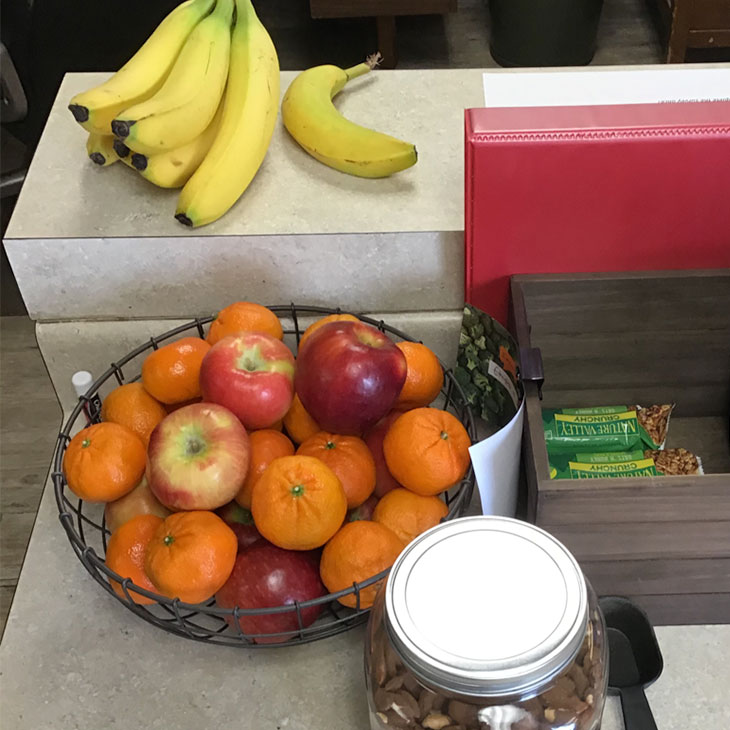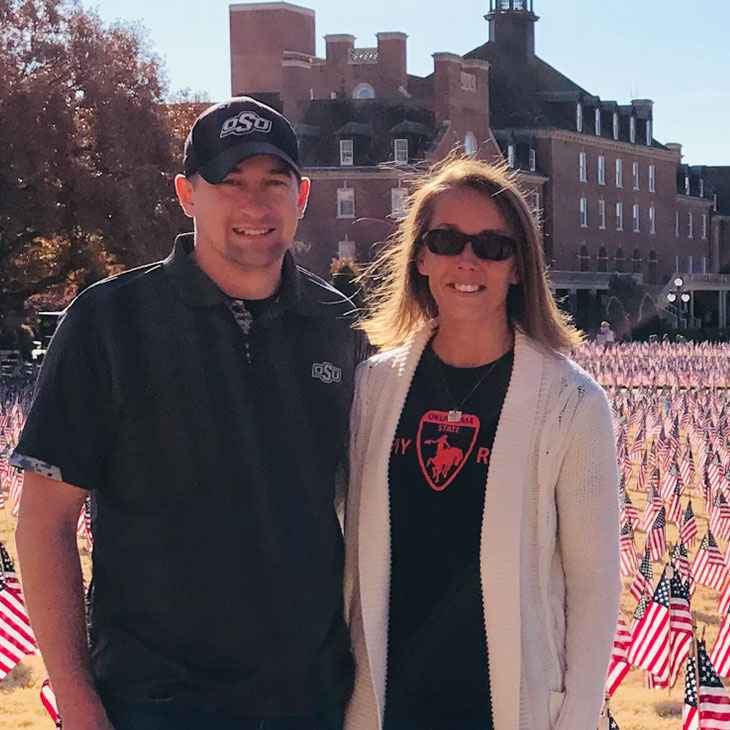
Heart of the Matter: OSU helps Stillwater firefighters change up their diet to fight heart disease
Wednesday, November 30, 2022
Media Contact: Kirsi McDowell | Senior Communications Specialist | 405-744-9347 | kirsi@okstate.edu
An alarm jolts you out of the small twin bed as you are catching the little sleep that can be attained in the constantly alert life of being a firefighter.
You get dressed quickly as you have been trained to do, go out on the call and you put out the fire. Over and over, throughout your 48-hour shift. No matter what fire, the smoke inhalation takes a toll. The lack of sleep takes a toll. And obviously the stress of such a dangerous job takes a toll.
When you aren’t on a call and can hang around the firehouse, eating a snack or cooking some dinner for the crew, little do you know, your heart is taking a toll from that food, day in and day out.
Heart attacks have become the leading cause of death in firefighters in the line of duty, not only because of all the risks and stress associated with the job, but also the food at most firehouses. The average age firefighters die from a heart attack is 45, 20 years below the national average for the general U.S. male population, according to the American Journal of Cardiology.
Dr. Jill Joyce, an Oklahoma State University nutritional sciences professor, read about this troubling statistic and decided to do something about it.
“When you see heart attack, you think, 'Well, it could be the job. Because that alarm goes off and their blood pressure goes through the roof, a sudden burst of having to go without any warm up or stretching on an adrenaline rush,” Joyce said. “I mean, it makes sense with the heat, fire, oxygen tanks, smoke. So maybe it is the job. And to an extent, it is.
“But if you look at the leading personal health problems for firefighters, it's being overweight and obesity, high blood pressure and high cholesterol. So something’s got to be going on with their nutrition.”
She asked the firefighters to help her take pictures of the station kitchens to get an idea of what their food environment was. Joyce worked with several students using a tool called Photovoice to help assess the environment, as well.
“There's a lot of refined grains, added sugar, sugar sweetened beverages, different kinds of sweets, fried foods, foods high in sodium. It's your typical snack/ dessert type foods,” Joyce said.
The project members started delivering healthier options to the four Stillwater Fire Department stations. The students would then log what foods were consumed and how the firefighters were responding to it.
The group brought different fruits, vegetables and snacks to the fire stations for
the study. They included mandarins, apples, bananas, lightly salted roasted almonds,
carrots, broccoli, Greek yogurt dip, hummus and Nature Valley bars.
Joyce said she wanted to ensure she didn’t just tell firefighters not to eat the unhealthy options, though. But rather put them in cabinets or somewhere that they weren’t visible so they weren’t as tempted to eat them.
“I didn't want to take away the unhealthy food because if I tell them they can't eat something, what are they going to do? The minute I am gone, it's going to come out of the woodwork,” Joyce said.
Instead, Joyce and her group used a psychological tool called behavioral economics to assist them in their nutrition study. The goal was to make the healthier foods more normal, attractive and convenient to the firefighters.
Kristen McClanahan, a doctoral student who was working on her undergraduate honors thesis at the time, said behavioral economics is a tool a lot of grocery stores and fast food companies use to promote their products. So, OSU’s project was to use it for healthier options.
“Basically, you just use gentle nudges,” McClanahan said. “For example, the size of your plate, the bigger your plate is, the more food you can put on it and the more you eat, the smaller your plate, the less we put on it and the less we eat."
The study ran throughout the spring and the students said they began to see a change in the firefighters while also learning some crucial real-world experience for the nutritional field.
Ashton Greer, a nutritional sciences major, said she delivered snacks to SFD Station No. 4 twice a week. She then checked to see how much of that was eaten.
“This opportunity helped me as a grad student because it helped me realize how hard it can be for first responders to have a healthy lifestyle,” Greer said. “I think it would be very beneficial if first responders had someone who was responsible for getting them groceries and/or help them eat more meals that are well balanced and that incorporate a variety of different foods.”
Bailey Golden, a biology premed major who is minoring in psychology and microbiology, said she was in charge of analyzing data behind the scenes so they could track the study’s progress.
“This has helped me in my degree program by being able to notice the impacts of nutrition and how the body can be impacted from it first hand,” Golden said. “It has also allowed me to see that with a little guidance and motivation, actions can change if the person is willing to put in the effort, which is interesting in a psychology aspect.”
For Joyce, it was a successful study because she began to see a change in the firefighters’ overall well-being when she would chat with them. The fire stations also had members who are in charge of fitness for the different teams.
David Westfall, a 27-year veteran of the Stillwater Fire Department, is one of those fitness coordinators and said the OSU project was well received.
“I would say some of the guys try to eat somewhat healthy but then you have the other guys that have never really been exposed to that,” Westfall said. “So that was a great program for those types of people or just even the ones that do try to eat healthy, it was available to them at all times. It made it very beneficial for that."
Mealtime at a fire station has always been an important bonding time and many firefighters are known for their cooking skills, so Joyce helped SFD in that aspect, too. She provided them with cookbooks that had healthier recipes and for shifts that the firefighters might have to eat out occasionally, Joyce gave them pamphlets with healthy options at the restaurants around Stillwater.
Westfall said that was a big help, since most of the older recipes that still circulated included unhealthy, carb-loaded entrees like tater tot casserole.
“Those recipes stay in stations and it's tradition that you kind of just continue to make those things, but providing a recipe book with new fresh ideas, innovative new recipes, that helped out a lot, healthier options using ground turkey,” Westfall said. “Just less fats and just basically healthier options of meals for guys to cook because we do try to cook several meals while we're on shift.”
Although Westfall said he’s always eaten healthy, he said it was convenient to have those options around the fire station that he didn’t have to bring in.
“It was very convenient to already have those options in the stations and alleviated us having to go to the store to buy them,” Westfall said.
McClanahan said the most popular item she saw being consumed was the whole grain granola bars since they could just take them on the go.
As the spring semester winded down, the food project ended as well, but Westfall said he thinks a lot of the healthier habits are here to stay.
“There definitely hasn't been an influx of new junk food really coming into the station,” Westfall said. “So even though that program discontinued, it seemed like it was definitely beneficial because it stuck, that lifestyle is kind of stuck with a lot of the guys.”
Joyce said getting to hear things like that from the firefighters meant her study was viable. Eating healthier can not only stop the risk for heart disease, but also cancer, which has a high rate among firefighters, too.
“It's crazy how that's literally all I'm doing is dropping off food. But the air has just changed,” Joyce said. “They're health culture has changed. They're thinking healthy.”
In terms of impact, Westfall said he could see the healthier habits that started at
SFD because of the OSU study could also spread to the local communities by word of
mouth. Joyce said there is even a possibility these options could work in other high-stress
first responder positions in police, health care and the military.
In some ways, this was a passion project for her. Coming from law enforcement, fire and military families and married to a veteran, OSU academic advisor Tom Joyce, she wants to ensure first responders are taking care of themselves.
“It's kind of the heart of our family, that we live for serving. I wanted to be in the military and I tried a few times to get in,” Joyce said. “So, I think I’m finally getting my chance to serve. We love it, these are our people.”
Story By: Jordan Bishop | ASPIRE Magazine
Photos By: Phil Shockley and Provided
